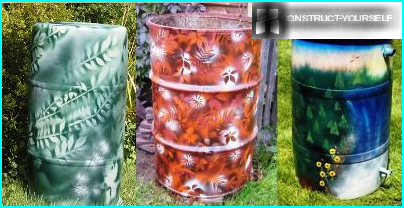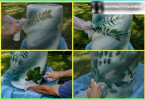
Practicality has always been one of the best qualities of a successful vacationer. Business owner of suburban housing and the house will prosper and yield a rich collect, and apples in the garden will grow the largest and rosy – and all because it applies only a good experience, and is not afraid of experiments. Why, for example, not to turn a flourishing flowerbed in a compact garden Cabinet or in the garden do not break medicinal flower garden? Try to understand, whether useful plants to replace the traditional Phlox and asters by its decorative characteristics.
The contents
Where healing flower garden
Our task is to arrange the cottage flower garden, but not normal, but only treatment to every plant in the flowerbed had useful properties such as medicinal or cosmetic.
Dug a few roots and made an infusion for gargling, tired of a few flowers, fragrant and soothing tea is ready. But our plants need to bloom beautifully, or, in extreme cases, have distinctive leaves. Fortunately, among the medicinal flora of the dozens of such examples, but we will focus only on some.
The most simple solution is to plant flowering medicinal herbs some ready-made beds. It is no secret that among useful plant species there are specimens with a fluffy buds beautiful buds
Instead of delphinium can be planted like a willow, better known as Ivan tea, and hyacinths are to be replaced with lavender. The appearance of a blossoming flower beds will not change, but each new plant is valuable for its medicinal properties.
If you’re not used to «green first aid kit», can do so, but experienced «healers» always stocking up on nutritious grass for the future, the little bitty flower bed will not be enough. Fresh stems, leaves, buds and roots are used immediately, but most of them are dried and used throughout the year.
Therefore, 2-3 bushes will not be enough, it is better to prepare several flower beds, tiered flower bed or a small pharmacy consisting of klubochek, plants in pots or containers, which in winter can be stored in a closed terrace.
The fact that not all medicinal perennials are able to survive the harsh winter, so containers are the perfect mobile tool for seasonal decorations country areas.
Recommend to medicinal herbs «to stake a claim» flower beds near a residential building, summer kitchen or gazebo – that is, a place where in the future it will be convenient to work with plants (to prepare decoctions, tinctures, drying, etc.)
If this is not possible, you can use any area of the garden, garden or even areas for children to play. The main thing – that our beds did not prevent, but rather served as a decoration of the suburban area.
Useful plants for flower beds: planting, growing, caring
Almost all medicinal herbaceous plants in bloom. Some small inconspicuous flowers (yarrow), other bright buds (Badan drug, digitalis). You can plant those and other or combine them, creating a wonderful composition. Can the rows of brightly flowering plants to alternate with the greens, as the leaves of many grasses look spectacular. For example, Solomon’s seal drug recalls Lily of the valley, and chervil – fern.
Consider the growing conditions for those herbs that are familiar from childhood, freely sold in pharmacies and used at home. Each of the plant safely, if not exceed the dosage. Also do not forget about individual intolerance and allergic reactions, so consult your doctor before use, (or even garden experiments) is required.
St. John’s wort — for all diseases
Our grandmothers did not grow St. John’s wort, and collected tall stems with bright yellow flowers in the fields right outside the village. Now to find a pure land with safe soil and plants is difficult, much easier to grow useful herb at his dacha. As we sow St. John’s wort directly on a bed.
St. John’s wort is a perennial plant, it is necessary to take into account when arranging flowerbeds. With proper care, bloom starts by the end of the first year and in second year there is a numerous and rich flowering
You need to sow in autumn to spring, there were strong seedlings. Choose a place closer to the center of the bed, as the height of St. John’s wort reaches 30 cm of the Treated soil: perekidyvaem with compost or peat, add a little flower fertilizer. The distance between the rows is 40-45 cm.
The seeds are not buried, but left on the surface, pushing slightly into the soil. During hot and dry springs better to use a pot method of growing and the soil is ready to plant seedlings. Six weeks after germination is necessary to have a supply NPK – 2 g/m?.
Primary care of the St. John’s wort – weeding and supplemental watering in drought. Starting from the second year of planting give 150-200 g of dry raw material from 1 m?
Mint — for vitality and freshness
Undemanding plant with a pleasant aroma, many grown in the gardens and we will plant it in the flowerbed.
Mint can not boast of luxurious buds, but perfect for edging higher flowering herbs.
One of the main benefits of peppermint is undemanding to growing conditions: it is to be adjusting well in any soil, withstands dry season, it grows well under sunlight and in partial shade
In the autumn planting in the ground make biological fertilizers – manure, compost, wood ash. We need pre-prepared sprouts or cuttings of the rhizomes. Given the rapid growth left between the nests of intervals up to half a meter. Spring mint requires abundant watering.
To achieve a decorative effect and to make bushes flat, the tops of the main stems primitives. Peppermint is growing actively, so care is weeding, watering, and infrequent tillage. The sun bushes will be more lush and tall, in the shadows – miniature.
Due to the high humidity mint can get sick «rust». Do not rush to feed with chemical fertilizers (sometimes the disease occurs through their fault) – remove large branches and make the soil a little compost, limbs will be healthy
Sunny calendula
Varieties of calendula so much that just using it to decorate a few flower beds. Plant height (from 20-centimetre to metre) allows you to make all kinds of multi-layer composition. Many people love calendula for its long flowering period. Due to the cold resistance of the plants do not wither and freeze up to -5?With.
Decorative possibilities are limitless calendula: many varieties (hamlet, Favorite, Sensation, Kabloona, Medallion, the Golden ball, meteor, Radio) is rich in shades from pale yellow to bright orange or light brown
Calendula, or «marigolds», loves the sun and moderately moist soil. On the shaded area growth slows and stems, and inflorescences. It is better to sow in October, right in the open ground. Spring crops to grow and bloom much later.
Seeds placed in the soil to a depth of 2-3 cm, have a 30×30 cluster method. With this planting, the plants will be tall and curvy. If the required rows – sow «track» at intervals of 5-6 cm.
To protect the hair from powdery mildew and similar diseases spotted, before flowering of the treated stems and leaves of garden tool «Topaz», and withered blossoms and dead leaves promptly remove
Fragrant lavender
The most popular varieties of lavender – English, Dutch, real, schadzka, gear. Plants of different species differ in height, leaves, colors and inflorescence shape.
Pink, blue and purple, lavender is in flower beds to create an expressive floral bright background or a neat border, combined with white, red and blue hues and greens
Lavender likes Sunny areas and is intolerant of waterlogging, so in swampy areas need drainage or raised beds. For the regulation of acidity in the soil, you can add wood ash, and the looseness of the compost, then flowering will be especially plentiful.
If it is difficult to fulfill all the conditions, buy a variety of Lavender deciduous – it is undemanding and thrives in any soil.
Be careful with nitrogen fertilizers – they affect the development of stems and leaves, while the inflorescences become lush enough. Lavender is better to feed potash fertilizers
The easiest method of propagation – stem cuttings. Twig is bent, pressed to the ground, cover and fasten cargo or pin. For rooting you need a few months. Once formed roots, strains cut, and the cut to protect the treated coal.
Valerian — cat joy
Calming Valerian drops on familiar not only to people, our Pets – cats and cats of various breeds — with pleasure gnaw dried roots for that amazing plant called cat grass.
Small, fragrant, collected in large inflorescences of pinkish-white flowers of Valerian more background, so easy to fit in any floral arrangement, besides they bloom all summer long, which will only benefit our medical bed
Sowing the seeds produced in July, and then will need transplanting in September. Do in the soil shallow grooves, put the seeds and cover them with soil, the best dirt.
After about a couple of weeks will see the seedlings, which after the emergence of the fourth leaf are transplanted to a permanent place of growth. The soil of flower beds should also be enriched with compost, dig up and loosen.
Plants that remain in the bed for «wintering», should be fertilized with NPK or similar fertilizer (containing phosphorus and nitrogen), it is enough 50 g per 1m?
If you sow the plants in early spring, then by autumn they will give the first crop of rhizomes, and the summer landing will be useful for next year.
Sage — a universal healer
In the Northern regions, it is preferable to grow hardy and healthy varieties – Patriarchal Semko, Nectar, Dolittle, a breeze. These species are included in the state register of the Russian Federation and officially recognized by the medical.
Sage forms a high, lush clumps of blue, so when decorating the flower beds the best place will be the Central or at the wall (fence), if the bed is adjacent to the fence
For landings you need a soil of medium acidity (pH 6.5), good lighting. Suitable moderately moist loamy soil. As the fertilizers used compost, humus and floral potash and nitrogen recharge.
Note: it is not recommended to sow seeds in the areas where previously native relatives sage. The best option is soil from under legumes, potatoes, cabbage or onions
Plant seeds in October or early spring, making a cluster method or grooves at intervals of 25 to 45 cm. Make shallow 2 cm, cover loose soil. In one place the sage develops a sufficiently long period — up to 8 years.
The design of the pharmaceutical flower garden
Let’s start with the fact that the shape and size medical beds are no different from the usual. Suppose you already picked up a few useful plants that differ in height, pomp, colours and size of blossoms. Our task is to make itself a bed and place it on the plant so that overall composition looks attractive and not recalled spontaneously and haphazardly planted culture.
The shape of the bed can be round, oval, square, rectangular or elongated along the facade of the house or fence. If it is in the center of the site, you can use the combo design.
Original two-tier design is perfect for creating a healing flower garden: the sectors of different shapes can be filled with crops and flowers in different shades, contrasting or related
The idea to raise the beds is not new – with the help of raised designs to create gorgeous flower beds-pyramid. On the technical side, such structures also have the advantage: they are comfortable to make a drainage layer for the plants do not like too wet soil.
If you are used to work with raised beds, you can create a flowerbed in the form of a mini-vegetable garden: to divide a large area into sectors, resembling separate beds, and planted them with flowering crops
Planted plants of the same species just a lot harder to make songs from different cultures within the same beds. It is necessary to consider all the details:
- the time of flowering;
- the height of the stems;
- the shape and shade of flowers.
- activity growth.
The rest depends on the imagination of the grower. Here is an example flowerbeds, which includes the composition of the 12 plants. Of course, medicinal raw materials, it can give a little bit, but decorative effect is excellent.
Residents beds: 1 — parsley; 2 onions used; 3 thyme; 4 — peppermint; 5 — Daisy; 6 — rosemary; 7 — oregano; 8 — estragon; 9 — sage; 10 — Echinacea; 11 — lavender; 12 — hyssopus officinalis
Advice on the application of useful herbs
We remind you again that before using any cosmetic, and medicinal herbs necessary to clarify, whether you have allergies to them.
Bright and expressive nasturtium, which we used to use as a basket floral decor, and even useful: it helps with hypertension, bronchitis and anemia
If everything is in order, consider the cases in which can be useful to our bed-kit for the city when there are nearby pharmacies and clinics:
- Pharmacy Daisy indispensable for colds: inhalation, gargling decoction, medicinal tea.
- Echinacea and St. John’s wort strengthen the immune system.
- Anti-inflammatory properties of calendula will help with sore throat and stomatitis.
- Tea with mint and Melissa aren’t just delicious, more useful – invigorates, refreshes and improves digestion.
- Skin rashes and small scratches are treated with a decoction of celandine, succession, and St. John’s wort.
- Sage is indispensable for bronchitis, and gastro-intestinal inflammations.
If properly used useful plants, half of medicines from your first aid kit brought from the city will remain untouched.
Echinops ordinary known to those who has problems with the cardiovascular system. It increases the elasticity of blood vessel walls also helps with headaches, polio and multiple sclerosis
It turns out just to be practical, to harmoniously combine the beauty and benefits of plants! And care of drug crops needed no longer than traditional flower gardens.
And finally about how to grow herbs in the North, on the island of Kizhi:






